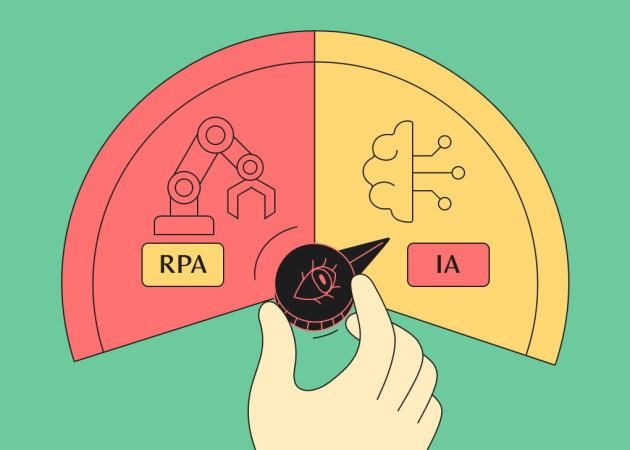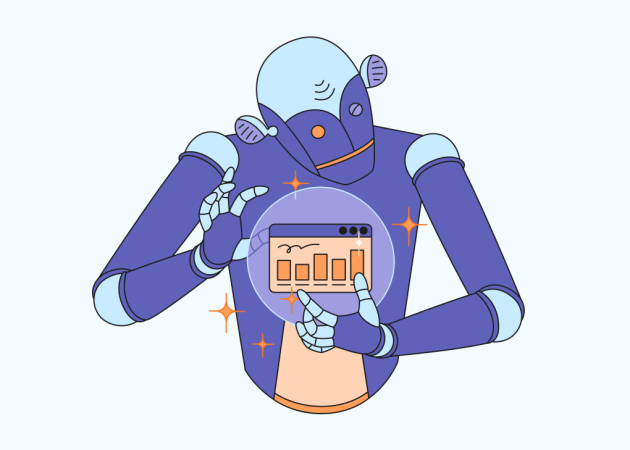
Under the Hood: How AI Agents Work in Enterprise Systems
Contents
Contents
You’ve likely heard the story: AI agents will revolutionize your business processes. But beneath that statement lies a fundamental question — how do these systems actually work?
This is where the understanding of AI agent architecture becomes critical. When you’re evaluating agentic AI services in the market or explaining capabilities to your board, you need to know the technologies behind the buzzword. More importantly, you need to grasp the trade-offs, limitations, and real costs involved.
Let’s break down the core components that make an AI agent tick, so you can make informed decisions about where and how to deploy them in your organization.
The Core Blueprint of AI-Based Agents
An AI agent is an automation system. It has three critical components: a “brain” for reasoning, memory for context, and an orchestrator for coordination. Each component involves technology that will directly impact your costs, compliance requirements, and business outcomes.
Component 1: The “Brain” (LLMs)
The large language model (LLM) is your agent’s reasoning engine. It processes inputs, makes decisions, and generates responses. At the beginning of their agentic AI journey, companies face an important decision: closed vs. open-source models?
- Closed-source models like GPT-4 offer great performance out of the box. They handle complex reasoning better, produce more reliable outputs, and require less fine-tuning. For customer-facing applications or complex analytical tasks, they’re often worth the premium. You’re paying for reliability and reduced development time.
- Open-source alternatives like Llama 4 give you control and cost predictability. You can run them on your infrastructure and customize them for specific use cases. The trade-off? The need for strong technical capabilities in-house and more time to achieve production-ready performance.
The pricing models fundamentally differ in ways that impact your budget planning. Closed-source models charge per usage, typically per token processed. This creates variable costs that scale with your success but can become unpredictable. Open-source models require upfront infrastructure investment (GPU servers, storage, and technical expertise), but offer predictable ongoing costs. The break-even point typically occurs around moderate to high usage scenarios.
For organizations in highly regulated industries, model choice often comes down to data control. Closed-source APIs typically process data on vendor infrastructure, which may conflict with compliance requirements, especially for HIPAA and GDPR.

Open-source models can run entirely on your infrastructure, which means data never leaves your control. This tackles the challenge of regulatory requirements but creates operational complexity. Your team is responsible for securing the infrastructure, managing model updates, and guaranteeing consistent performance across your deployment environment.
Here’s what this means for your business: If you’re processing sensitive data or operating in heavily regulated industries, open-source models deployed on-premises might be non-negotiable. If you need to move fast and have budget flexibility, closed-source APIs can accelerate your time to value significantly.
More insights:
Component 2: The Memory
Memory in AI agents gives them the context they need to maintain coherent, purposeful interactions over time and across sessions.
Short-term vs. Long-term Memory Architecture of AI Agents
Short-term memory handles the immediate conversation or task context. It’s typically managed within the model’s context window. You can think of it as the agent’s working memory. This is where current conversation history, immediate task parameters, and real-time data live.
LLM providers have introduced prompt caching to optimize this short-term memory management. Prompt caching allows you to cache frequently used context (e.g., system instructions, large documents, or conversation history) on the provider’s infrastructure. Instead of reprocessing the same tokens with every request, the cached portions are stored and reused.
This is particularly valuable for enterprise agents that maintain consistent system prompts or reference the same knowledge base across multiple interactions.Providers like Anthropic, OpenAI, and others offer this feature, though implementation details vary.
Long-term memory is where the strategic value lies. This is persistent storage of interactions, learned preferences, historical decisions, and accumulated knowledge. For enterprise applications, this often means integrating with your existing data systems like CRMs, knowledge bases, and operational databases.
Agents access this long-term memory through tools and direct integrations. They can call APIs directly or execute database queries to retrieve specific data for processing.
Here, frameworks like Model Context Protocol (MCP) play an essential role. MCP serves as a standardized way for LLMs to interact with external data sources. For example, your agents can invoke tools to query your CRM for customer history or pull real-time inventory data from your database.
The LLM decides when to use these tools based on the task at hand, executes the function call, receives structured data back, and incorporates that information into the response.
Vector Databases and Retrieval-Augmented Generation
Vector databases store information as mathematical representations that AI models can quickly search and retrieve. When your agent needs to answer questions about your company’s policies, customer history, or product specifications, it queries these vector representations to find relevant information.
Retrieval-Augmented Generation (RAG) combines your LLM’s reasoning with your organization’s specific knowledge. Instead of hoping the model was trained on your data, you’re explicitly providing relevant context for each query. This approach offers several advantages for enterprise deployment.
In practice, RAG implementations often involve enriching document chunks with metadata, which enables more targeted retrieval and proper filtering based on user context. The pattern you select depends on your data characteristics and retrieval precision requirements.
The technical implementation matters for your costs and performance. To learn more about how we can help you, consult our custom LLM solutions. We also provide ML as a service that covers everything from ML consulting to tech workshops.

How Agents Interact with the World
AI agents aren’t isolated entities. Their value comes from the ability to interact with your existing enterprise systems and take meaningful business actions.
The Integration Reality
Your agents may need to connect to APIs, read from databases, access CRM systems, process documents, and potentially trigger business workflows. Each integration point introduces complexity, security considerations, and potential failure modes.
The process usually goes like this: External inputs activate the agents through APIs or scheduled tasks. Agents handle these inputs with its LLM and memory systems. Depending on its reasoning, they produce outputs that may involve API calls to other systems, updates to databases, document creation, or notifications to people.
INPUT SOURCES → AGENT PROCESSING → OUTPUT ACTIONS → BUSINESS IMPACT
For your planning purposes, consider that each integration point requires dedicated development time, ongoing maintenance, and security review. A seemingly simple “customer service agent” might need to connect to your CRM, ticketing system, knowledge base, and payment processor, and each requires careful authentication, error handling, and monitoring.
Guardrails and Oversight: The Non-Negotiables
Enterprise AI agents need oversight mechanisms. It’s essential for compliance, risk management, and operational reliability. Effective guardrails operate at multiple levels:
- Input validation makes sure agents only process appropriate requests and data.
- Content filtering prevents inappropriate or harmful outputs.
- Action approval workflows require human sign-off for high-risk decisions.
- Audit logging tracks all agent decisions and actions for compliance and debugging.
The oversight architecture you choose will significantly impact your implementation timeline and operational overhead. Fully autonomous AI agents move fast but require sophisticated monitoring. Human-in-the-loop systems are safer but slower and more expensive to operate.
At the same time, you can design your agent systems to fail safely. When errors occur (and they will), agents should default to conservative actions rather than risky ones. If an agent can’t determine an appropriate action with sufficient confidence, it should reach out to an expert rather than make uncertain decisions.
As an option, you can implement circuit breaker patterns that automatically disable agents when error rates exceed acceptable thresholds. If your customer service agent provides incorrect account information, it should stop processing requests and alert human operators rather than continuing to serve customers poorly.
Lastly, it is advisable to build rollback capabilities for agent actions. When agents make mistakes that impact business operations, you need quick ways to undo or correct their actions. This requires detailed transaction logs and reversible workflows wherever possible.
Component 3: The Orchestrator
The flow between the brain, memory, and external AI agent tools, as well as handling complex multi-step tasks, requires an orchestrator. It coordinates between the LLM, memory systems, external integrations, and business logic. This component often determines how quickly you can iterate, scale, and maintain your agent implementations.
Orchestration frameworks like n8n, LangChain, LlamaIndex, and Microsoft’s Semantic Kernel provide the infrastructure for agent workflows. They handle the plumbing — prompt management, model switching, memory coordination, and tool integration.
Your AI agent framework will impact your team’s productivity and your long-term maintenance costs. More importantly, it will determine how easily you can adapt your agents as business requirements evolve.

Building a Simple Research Agent
Let’s take a closer look at a concrete situation that you might have encountered: a leadership team wants a weekly briefing on AI trends affecting your industry. Currently, someone spends hours each week researching, summarizing, and formatting this information. Here’s how an AI research agent would handle this task.
Monday morning, 9 AM. Your research agent receives its weekly trigger. Instead of a person spending their morning scanning dozens of sources, here’s what happens behind the scenes.
The agent’s brain (LLM) first interprets the briefing requirements stored in its instructions: “Focus on enterprise AI adoption, regulatory changes, and emerging technologies relevant to financial services.” It then queries multiple sources — industry publications, research databases, regulatory websites, and your curated list of thought leaders.
The memory system kicks in, comparing this week’s findings against previous briefings stored in the vector database. It identifies truly new developments versus recurring themes. The agent also recalls your team’s previous feedback.
The orchestrator coordinates the entire workflow. It schedules searches across different sources, manages API rate limits, handles data processing, and works with your content management system. It ensures the research meets your predefined quality standards and compliance requirements.
By 10 AM, a brief lands in your leadership team’s inboxes, complete with source citations, risk assessments, and use cases specific to your industry.
Important Governance Requirements
To make that happen, you need clear policies about data sources, content accuracy standards, and decision escalation paths. Who validates the source selection of your agents? How do you handle controversial or conflicting information? What happens when agents miss a significant development?
You might want to establish content approval workflows for sensitive topics. Define clear boundaries about what agents can research and report. Create regular audits of source quality and bias detection. Your governance framework should address both the accuracy and appropriateness of the research scope.
Accountability and audit trails play a crucial role in this process. Every agent decision needs to be traceable. When your research agent excludes a particular development from the briefing, document why. It’s about improving agent performance through feedback loops.
You can also set up regular reviews to check agent’s’ decisions against business outcomes. Did the agent overlook early signs of market changes? Did it put too much focus on developments that turned out to be unimportant? Use these insights to improve source selection, modify weighting algorithms, and enhance escalation triggers.
It is also possible to implement automated review processes with separate agents. A supervisor agent can periodically audit another agent’s decisions. For example, a QA agent might review your research agent’s daily briefings against the source material to flag potential issues.
The Future of AI Agents
As the underlying technologies mature, we’re moving toward more complex multi-agent systems that can handle complex, multi-step business processes.
The next generation of business AI will involve agent teams. Imagine a customer acquisition process where a research agent identifies prospects, a qualification agent scores leads, a content agent personalizes outreach, and an analysis agent optimizes the entire funnel based on results.
These multi-agent architectures will require more sophisticated AI agent orchestration and governance frameworks. You’ll need to plan agent-to-agent communication protocols, shared memory systems, and coordinated decision-making. The complexity increases exponentially, but so does the potential business impact.
We’re rapidly approaching true business process automation, where agents don’t just provide analysis but execute decisions. Your research agent might automatically adjust marketing spend based on competitive intelligence or trigger strategic planning sessions when it finds significant market shifts.
This requires deeper integration with your ERP, CRM, and business intelligence systems. It also demands more sophisticated approval workflows and risk management frameworks. The stakes get higher when agents move beyond information processing to business action.
As AI agents become more widespread in business, regulatory frameworks will evolve to set boundaries for their use. Industry-specific guidelines for AI decision-making are already emerging in finance, healthcare, and legal services.
Stay ahead of these developments by building compliance capabilities into your agent architectures from the start. Maintain audit trails and establish human accountability for agent actions with Beetroot. The organizations that integrate compliance considerations early will have significant advantages as regulations tighten.

Final Thoughts
Understanding the architecture of an AI agent (the LLMs, the memory, the orchestrator) and its connection to your business world is the first step toward building a coherent AI strategy. It demystifies the technology, moving it from a buzzword to a tangible set of components you can assemble to solve real-world business problems.
By focusing on this core blueprint, you can create intelligent, secure, and well-governed agents that don’t just perform tasks but create a durable competitive advantage for your enterprise. Connect with Beetroot to access the expertise and technology needed to bring your AI agent solutions to life.
FAQs
What is the difference between an AI model (like GPT-4) and an AI agent?
An AI model is the reasoning engine. It processes inputs and generates outputs, but it can’t take actions or remember previous interactions. An AI agent is a complete system that uses an AI model as its “brain” but adds memory, integration capabilities, and the ability to execute tasks in your business environment. The model answers questions; the agent completes workflows.
Why is memory so vital for AI agents?
Without memory, every interaction starts fresh. Your customer service agent would ask for account details every time. Your research agent would repeat the same searches weekly. Your workflow agent couldn’t build on past decisions. In this case, it’s important to distinguish between context and memory. Context is what you provide programmatically for a specific interaction (e.g., the conversation thread, task parameters, or relevant documents). Memory is persistent information that carries across multiple interactions: learned user preferences, historical decisions, or patterns from past conversations.
What is LangChain, and why is it popular for building agents?
LangChain is a framework for AI agents. It handles model switching, prompt management, memory coordination, and integration with external systems. It’s popular because it solves the tedious infrastructure problems that every agent developer faces, allowing teams to focus on business logic instead of technical connectivity.
Is it possible for AI agents to learn and improve over time?
Yes, but it depends on how you design the learning mechanisms. Agents can improve through feedback loops — storing successful interaction patterns in memory, adjusting responses based on user corrections, and refining their decision-making processes. However, this requires intentional architecture design and often human oversight to make sure the learning improves performance. Beyond runtime learning, you can employ fine-tuning techniques to improve the underlying model itself. This involves post-training the base model on a curated dataset of cherry-picked successful interactions from your production environment.
What are the main challenges in building reliable AI agents?
Some of the biggest challenges are integration complexity and unpredictable model behavior. AI models can produce unexpected outputs that break workflows. And as you deploy more agents, maintaining consistent oversight, security, and compliance becomes exponentially harder. Reach out to our team to learn more about how you can tackle these common challenges.
Subscribe to blog updates
Get the best new articles in your inbox. Get the lastest content first.
Recent articles from our magazine
Contact Us
Find out how we can help extend your tech team for sustainable growth.






